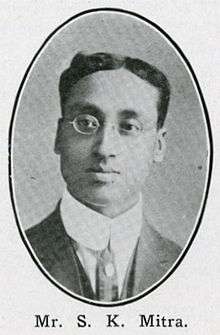Sisir Kumar Mitra
| S.K. Mitra MBE, FNA, FRS | |
|---|---|
 S.K. Mitra, from the January 1916 issue of The Hindusthanee Student | |
| Native name | শিশির কুমার মিত্র |
| Born |
Sisir Kumar Mitra 24 October 1890 Calcutta, Bengal Presidency, British India |
| Died |
13 August 1963 (aged 72) Ballygunge, Kolkata, West Bengal, India |
| Nationality | Indian |
| Fields |
Radiophysics Atmospheric physics |
| Institutions |
Bankura Christian College University of Paris University of Nancy University of Calcutta Curie Institute (Paris) |
| Alma mater | University of Calcutta |
| Doctoral advisor |
C.V. Raman Charles Fabry |
| Other academic advisors | Jagadish Chandra Bose |
| Known for | Work on the ionosphere |
| Notable awards |
|
| Spouse | Lilavati Biswas (1914-1939) |
Sisir Kumar Mitra (or Shishirkumar Mitra) MBE, FNA, FRS (October 24, 1890 – August 13, 1963) was an Indian Bengali physicist.[3]
Education
Mitra was born and raised in Calcutta. His parents were the doctor Saratkumari and the school teacher Jaykrishna. At the age of nine he witnessed a hot air balloon and became intrigued in the phenomenon, so he began studying science. The family moved to Bhagalpur, where Sisir attended school and the local college. After his father died, his mother supported him through Presidency College of the University of Calcutta where he earned a B.Sc. In 1912 he gained his M.Sc. at the same institution.
Career
Mitra briefly became a scholar performing research before becoming a teacher. Eventually he taught at Bankura Christian College. In 1914 he married Lilavati Devi.
In 1916, Sisir was invited to join the new postgraduate department of physics at the University Science College. He gained a D.Sc. degree in 1919; then he left for Paris, France to study at the University of Paris. There he earned a second D.Sc. and would join Marie Curie at her laboratory. He developed an interest in the new science of radio communication, and went to the University of Nancy to research this field.
In 1923 he returned to India where he was appointed Khaira Professor of physics, at the University of Calcutta. There, in addition to teaching, he established a laboratory to investigate wireless. He also initiated a new department at the University of Calcutta that later became the Institute of Radio Physics and Electronics.
In 1955 he retired from the university, becoming emeritus professor. He was given charge of the West Bengal Secondary Education Board, and spent six years organizing this administrative body.
He died following a short illness.
Among his accomplishments were his investigations into the ionosphere. Dr. Mitra proposed that ultraviolet light from the sun created the middle, or E layer, of the ionosphere. He also determined that ions in the ionosphere's F layer were what caused luminescence of the night sky, giving it a dusty hue rather than pitch black. In 1947 he published a reference treatise titled "The Upper Atmosphere" on atmospheric research.
Awards and honors
- Member of the Order of the British Empire (MBE), 1938[4]
- Fellowship of the Royal Society, 1958[1]
- Presidency of the Indian National Science Academy, 1959-60.
- National Professorship, 1962.
- Padma Bhushan, 1962.[2]
- S. K. Mitra Center for Research in Space Environment of the University of Calcutta is named for him.
- The crater Mitra on the Moon is named after him.
References
- 1 2 Ratcliffe, J. A. (1964). "Sisir Kumar Mitra 1890-1963". Biographical Memoirs of Fellows of the Royal Society. 10: 221–226. doi:10.1098/rsbm.1964.0013.
- 1 2 "Padma Awards" (PDF). Ministry of Home Affairs, Government of India. 2015. Archived from the original (PDF) on 15 November 2014. Retrieved July 21, 2015.
- ↑ S. K. Mitra, "The Upper Atmosphere", Calcutta, Royal Asiatic Society of Bengal, 1947.
- ↑ The London Gazette: (Supplement) no. 34518. p. 3704. 7 June 1938. Retrieved 9 July 2015.
5. Rajinder Singh, Nobel Prize Nominator Sisir Kumar Mitra F.R.S. - His scientific work in international context, Shaker Publisher, Aachen 2016. http://www.shaker.de/de/content/catalogue/index.asp?lang=de&ID=8&ISBN=978-3-8440-2654-2</